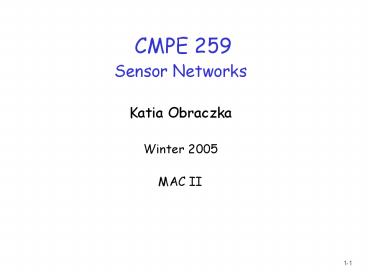CMPE 259 - PowerPoint PPT Presentation
1 / 21
Title:
CMPE 259
Description:
Simple election algorithm to suit systems with low memory and processing power ... Simulation Results (16 nodes, 500x500 area, CC1000 radio, grid topology, edge sink) ... – PowerPoint PPT presentation
Number of Views:47
Avg rating:3.0/5.0
Title: CMPE 259
1
CMPE 259
- Sensor Networks
- Katia Obraczka
- Winter 2005
- MAC II
2
Announcements
- Nacho will b talking about data aggregation on
Mon., Feb. 28th. - Exam Wed., March 2nd.
- Project status updates.
- E-mail 1 paragraph (plain text) describing
progress so far and what remains to be done,
plan, etc. - Project submission also includes project report!
3
Today
- Finish MAC.
- Start Storage, querying, and aggregation.
4
FLAMA (contd from last class)
5
TRAMA Limitations
- Complex election algorithm and data structure.
- Overhead due to explicit schedule propagation.
- Higher queuing delay.
Flow-aware, energy-efficient framework.
6
Flow-aware Medium Access
- Avoid explicit schedule propagation.
- Take advantage of application.
- Simple election algorithm to suit systems with
low memory and processing power (e.g., 4KB ROM in
Motes). - Incorporate time-synchronization, flow discovery,
and neighbor discovery during random-access
period.
7
Flow Information
- Flow information characterizes application-specifi
c traffic patterns. - Flows can be unicast, multicast or broadcast.
- Characterized by source, destination, duration
and rate.
8
Example Data Gathering Application
C
Fc
D
Fd
B
Fb
A
Sink
Fe
E
9
Flow Discovery Mechanism
- Combined with neighbor discovery during
random-access period. - Adapted based on the application.
- For data gathering application, flow discovery is
essentially establishing the data forwarding tree.
10
Example
Sink initiates neighbor discovery, flow
discovery, and time synchronization. Broadcasts
periodic SYNC packets. Potential children reply
with SYNC_REQ. Source reinforces with another
SYNC packet. Once associated with a parent,
nodes start sending periodic SYNC broadcasts.
B
SYNC
A
C
S
SYNC_REQ
Sink
11
Election Process
- Weighted election to incorporate traffic
adaptivity. - Nodes are assigned weights based on their
incoming and outgoing flows. - Highest priority 2-hop node is elected as the
transmitter. - A node listens if any of its children has the
highest 1-hop priority. - Can switch to sleep mode if no transmission is
started.
B
wc1
A
C
S
wc1
wa3
Sink ws0
12
Simulation Results (16 nodes, 500x500 area,
CC1000 radio, grid topology, edge sink)
Queueing Delay
Delivery Ratio
13
FLAMA Summary
- Simple algorithm that can be implemented on a
sensor platform. - Significant performance improvement by
application awareness.
14
Geographic Random Forwarding Zorzi e al.
15
Approach busy tones
- Nodes assumed to have 2 radios.
- One used for data and another for signaling.
- Receiver uses busy tone to prevent collisions.
- Transmissions are broadcast.
- RTS/CTS.
- Any node can receive to RTS.
- CTSs subject to contention.
16
Protocol operation transmitter
- Node has packet to send
- Listens to both frequencies for T.
- If either frequency busy, backoff.
- Otherwise, broadcast RTS with location of source
and destination. - Listens for CTS.
- If CTS received, sends data.
- If no CTS received after N trials, abort.
- If undistinguished signal, COLLISION.
17
Transmitter (contd)
- After packet transmitted, wait for ACK.
- If ACK received, done and sleep.
- Otherwise, retransmit.
18
Receiver
- Nodes wake up and listen.
- If no activity, go back to sleep.
- Otherwise, go to receive state and activate busy
tone. - When receiving RTS, node determines its priority
as relay. - Based on location info.
- First CTS slot, neighbors nearest to destination
send CTS. - Nodes listen for data.
- If data, only designated node receives all
others go to sleep. - Designated node is node that sent CTS
(specified in data packet header).
19
Receiver (contd)
- If CONTINUE, i.e., no node in closest region
replied with CTS, nodes in 2nd. closest region
will contend, - If ABORT, transmitter reached maximum number of
CTS slots. - If COLLISION, more than one CTS was received.
- Colliding nodes execute collision resolution.
20
Evaluation
- Analytical.
- Numerical results.
- Compared with STEM.
- Idle nodes sleep.
- Dual radio.
- Metrics
- Energy.
- Latency.
- Overhead?
21
Results
- From paper































